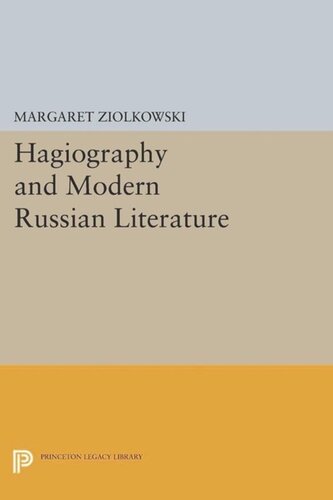

Most ebook files are in PDF format, so you can easily read them using various software such as Foxit Reader or directly on the Google Chrome browser.
Some ebook files are released by publishers in other formats such as .awz, .mobi, .epub, .fb2, etc. You may need to install specific software to read these formats on mobile/PC, such as Calibre.
Please read the tutorial at this link: https://ebookbell.com/faq
We offer FREE conversion to the popular formats you request; however, this may take some time. Therefore, right after payment, please email us, and we will try to provide the service as quickly as possible.
For some exceptional file formats or broken links (if any), please refrain from opening any disputes. Instead, email us first, and we will try to assist within a maximum of 6 hours.
EbookBell Team

4.1
20 reviewsThe heritage of medieval hagiography, the diverse and voluminous literature devoted to saints, was much more important in nineteenth-century Russia than is often recognized. Although scholars have treated examples of the influence of hagiographic writing on a few prominent Russian writers, Margaret Ziolkowski is the first to describe the vast extent of its impact. Some of the authors she discusses are Kondratii Ryleev, Aleksandr Bestuzhev-Marlinskii, Fedor Dostoevsky, Leo Tolstoy, Nikolai Leskov, Gleb Uspenskii, Dmitrii Merezhkovskii, and Maksimilian Voloshin. Such writers were often exposed to saints' lives at an early age, and these stories left a deep impression to be dealt with later, whether favorably or otherwise.
Professor Ziolkowski identifies and analyzes the most common usages of hagiographic material by Russian writers, as well as the variety of purposes that inspired this exploitation of their cultural past. Tolstoy, for instance, employed hagiographic sources to attack the organized church and the institution of monasticism. Individual chapters treat the influence of hagiography on the poetry of the Decembrists, reworkings of specific hagiographic legends or tales, and the application of hagiographic conventions and features to contemporary characters and situations.
Originally published in 1988.
The Princeton Legacy Library uses the latest print-on-demand technology to again make available previously out-of-print books from the distinguished backlist of Princeton University Press. These editions preserve the original texts of these important books while presenting them in durable paperback and hardcover editions. The goal of the Princeton Legacy Library is to vastly increase access to the rich scholarly heritage found in the thousands of books published by Princeton University Press since its founding in 1905.